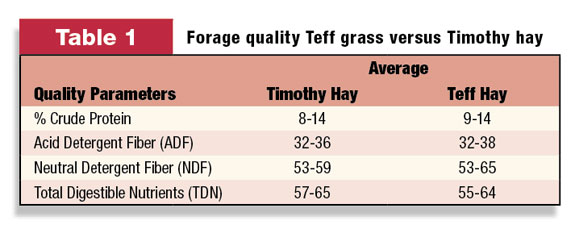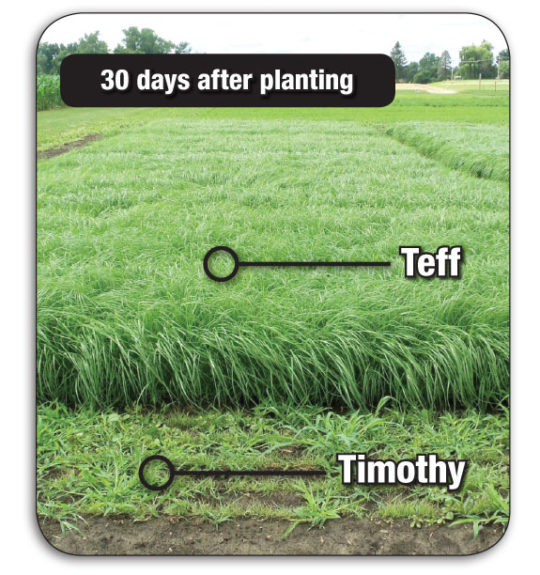Teff has a wide range of adaptation and is being used all across the U.S. as hay, silage or pasture for dairy, beef, sheep or horses.
The emerging popularity of teff has been driven by its ability to produce high-quality hay in a relatively short growing season with relatively low inputs (average nitrogen requirements per season are 30 to 60 units).
Teff can be planted in late spring and cut multiple times during the summer, with yields averaging 4 to 8 tons per acre, depending on the length of the growing season.
Teff’s high yield during the summer months is an advantage over cool-season grasses such as timothy, which normally have poor production following the spring harvest.
Advantages of teff
• Wide adaptation
Teff fits forage needs from southern New England down into central Florida, across the Midwest, Southeastern and Plains states, intermountain West and the Southwest desert region.
Teff has performed well on moisture-short to waterlogged soils and thrives when irrigated.

• Summer production
Teff is planted in late spring after danger of frost has passed, with multiple harvests during the hot summer months.
The forage can be used as feed to bridge the normal “summer slump” period of cool-season species or stored for the coming winter feeding season.
• Fast growth
Teff germinates quickly and is usually ready for first harvest at the early boot stage 35 to 50 days after planting. Subsequent cuttings are usually ready for harvest in 28 to 35 days, depending upon growing conditions and state grown.
• High yield plus high quality
Single-harvest hay yields are often in the 1.5 to 2.5 tons per acre with quality comparable to other high-quality forages such as timothy.
In multiple-harvest areas, summer yields can range from 4 to 8 tons per acre of hay with improved forage-type varieties.
• Harvest method
Teff can be harvested as dry hay, silage or grazed. However, the prevalent harvest method is dry, baled hay.
• Livestock palatability
Teff forage is fine-stemmed, leafy and “soft,” which is very palatable to livestock.
• No anti-quality compounds
Teff forage does not have anti-quality compounds such as nitrates or prussic acid that are associated with other summer annual species.

Feeding teff
Teff is considered premium hay for a wide range of livestock, including dairy, beef, sheep and horses.
Comments from livestock owners who have fed teff indicate it is very palatable and has demonstrated exceptional animal acceptance.
There have also been numerous anecdotal reports of improvements in animal coats as well as overall appearance.
Average weight gain in beef grazing trials in the Southeast have been reported as 1.5 to 2.3 pounds per day.
Recent horse feeding studies conducted by Pennsylvania State have demonstrated that teff would be a good choice for horse owners looking for relatively low non-structural carbohydrate hay.
Researchers stated that under their testing conditions, the following was found: “Intake and nutrient composition of the boot and early-heading maturities (of teff) was sufficient to meet 90 to 97 percent of the DE of the horses’ and most other nutrient requirements.
“For all maturities of teff hay, the non-structural carbohydrates (NSC) intake was below 10 percent of the total intake.
The low NSC and digestible energy (DE) of teff hay grown in central Pennsylvania under conditions in this study make it an appropriate forage source for obese horses and those at risk for laminitis or other metabolic disorders.”

More than just a high-quality horse feed
Teff has been a popular choice for horse owners; however, other livestock producers are now starting to look at the advantages of teff.
Teff’s fast yield and high-quality forage production during the summer heat helps provide producers with much-needed hay during the “summer slump” periods associated with cool-season grasses.
Dairy producers should take note of teff’s reported above-average animal acceptance and palatability, important factors in increased feed intake.
Producers who plan to feed their teff to lactating cows should pay special attention to harvest maturity. Like other grasses and legumes, teff’s forage quality decreases with maturity.
Harvest just before heading to maximize relative feed quality (RFQ) and dry matter yield. High-quality teff hay normally has a range from 100 to 125 RFQ.
Teff is best fed in a total mixed ration (TMR) to deter bunk-sorting. Most nutritionists will find teff easy to fit into the ration with the results of a good feed test and an adequate hay inventory.
Teff can be fed as dry hay to over-wintering beef cows or grazed by lactating cows during the summer slump period. For cattle on feed, follow the dairy suggestions above.
For sheep and goats, teff is a palatable forage that can be utilized as stored feed or grazed. Nutrient analysis of a wide range of teff hay has indicated that the copper content of teff hay, produced under normal growing conditions, is generally in the acceptable range for sheep.
Growing teff
For most commonly grown field crops, there are well established management practices for growers to follow.
However, with forage teff, the do’s and don’ts of crop management have been developed over the past decade and are still being refined.
For up-to-date crop information, visit www.teffgrass.com or www.producerschoiceseed.com for the newest edition of a downloadable “Teff Forage Production Guide.” FG
References omitted due to space but are available upon request.
PHOTOS:
Producers should take note of teff’s reported above-average animal acceptance and palatability. Photos courtesy of Don Miller.
- Dr. Donald R. Miller
- Director of Product Development
- Producer’s Choice











